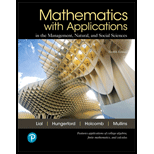
Concept explainers
Velocity Work these exercises. (See Example 5.)
A student takes off running to class, but slows down when she realizes that she will make it on time. The velocity of the student after t seconds is
a. Find a formula for the position function
b. If it took 15 seconds to get to class, find and interpret
Want to see the full answer?
Check out a sample textbook solution
Chapter 13 Solutions
Pearson eText for Mathematics with Applications In the Management, Natural, and Social Sciences -- Instant Access (Pearson+)
- Please help with a detailed explaintion on how to answer this questionarrow_forwardPlease help with a detailed explaination how to get the answerarrow_forwardMATLAB. Awnser written questions (*) in the comments. Null, Rank, and most functions outside of rref() and disp() are not allowed!arrow_forward
- MATLAB. Awnser written questions (*) in the comments. Null, Rank, and most functions outside of rref() and disp() are not allowed! Solutions must be given manually! Elementary form means to reduce to RREF manually, without rref(). Please see other attached image for explanationarrow_forwardIn ΔEFG, e = 520 inches, ∠E=26° and ∠F=107°. Find the area of ΔEFG, to the nearest 10th of an square inch.arrow_forwardIn ΔXYZ, ∠Y=90° and ∠X=25°. ∠ZWY=73° and XW=7.2. Find the length of WY to the nearest 100th. Figure not necessarily drawn to scale. XYWZ25°73°7.2?arrow_forward
 Functions and Change: A Modeling Approach to Coll...AlgebraISBN:9781337111348Author:Bruce Crauder, Benny Evans, Alan NoellPublisher:Cengage Learning
Functions and Change: A Modeling Approach to Coll...AlgebraISBN:9781337111348Author:Bruce Crauder, Benny Evans, Alan NoellPublisher:Cengage Learning Algebra and Trigonometry (MindTap Course List)AlgebraISBN:9781305071742Author:James Stewart, Lothar Redlin, Saleem WatsonPublisher:Cengage Learning
Algebra and Trigonometry (MindTap Course List)AlgebraISBN:9781305071742Author:James Stewart, Lothar Redlin, Saleem WatsonPublisher:Cengage Learning Algebra: Structure And Method, Book 1AlgebraISBN:9780395977224Author:Richard G. Brown, Mary P. Dolciani, Robert H. Sorgenfrey, William L. ColePublisher:McDougal Littell
Algebra: Structure And Method, Book 1AlgebraISBN:9780395977224Author:Richard G. Brown, Mary P. Dolciani, Robert H. Sorgenfrey, William L. ColePublisher:McDougal Littell- Algebra & Trigonometry with Analytic GeometryAlgebraISBN:9781133382119Author:SwokowskiPublisher:Cengage

 College Algebra (MindTap Course List)AlgebraISBN:9781305652231Author:R. David Gustafson, Jeff HughesPublisher:Cengage Learning
College Algebra (MindTap Course List)AlgebraISBN:9781305652231Author:R. David Gustafson, Jeff HughesPublisher:Cengage Learning





